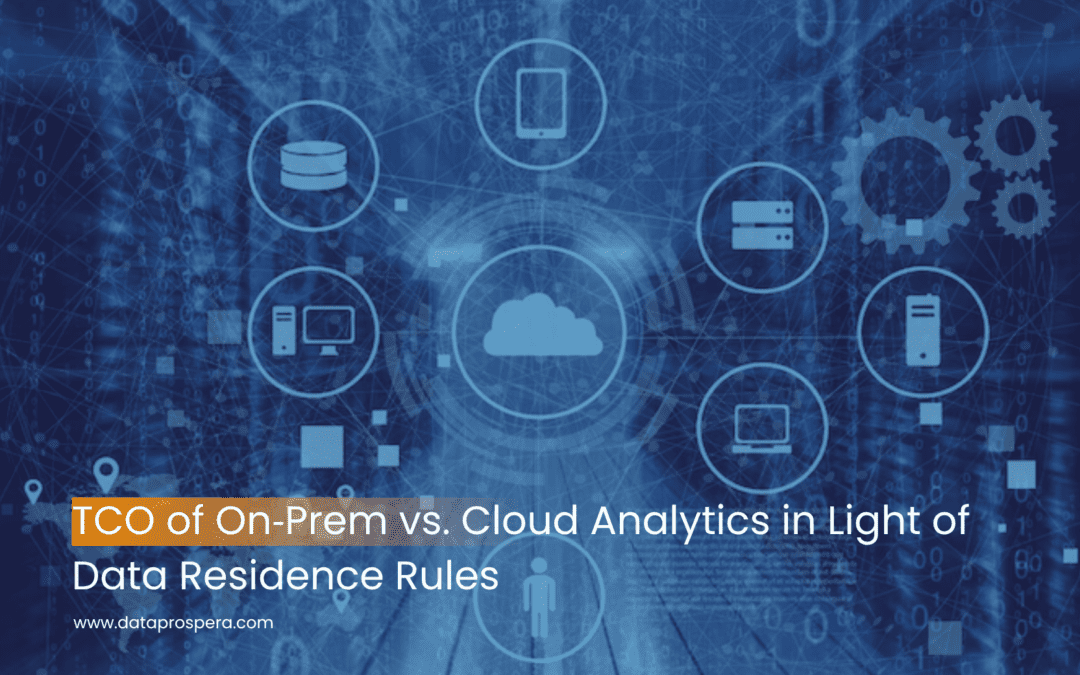1. The TCO Equation: Beyond the Numbers
When comparing on-premises and cloud analytics platforms under data residency constraints, businesses must look beyond upfront costs. TCO includes capital expenditures (CapEx), operational expenditures (OpEx), compliance overhead, and hidden expenses—especially when data must stay within national borders.
On-Prem Advantages
- Higher upfront investment but lower operating costs over time reddit.com+1reddit.com+1reddit.com+1phdata.io+1cioindex.com
- Beneficial for stable workloads—distributed computing, legacy systems, or regulatory compliance reddit.com
Cloud Advantages
- Minimal CapEx, pay-as-you-go billing, and built-in maintenance by providers
- Scalability and elastic resources—ideal for fluctuating analytics demands reddit.com+10udsenterprise.com+10reddit.com+10
2. Data Residency: Compliance Adds to Cost
Data localization mandates—like GDPR, PDP, or sector-specific rules—require analytics data to remain on domestic infrastructure. Cloud solutions often involve data egress fees or require regional cloud zones, introducing unexpected costs .
On-prem environments offer full control over where data resides, avoiding cross-border transfer fees. Cloud providers may partially offset this with specialized regional options, but compliance often demands architecture complexity that can increase TCO .
3. Hidden Costs and Long-Term Trade-Offs
- Energy and Facilities: On-premises require cooling, power, and physical space—costs that dissipate over time. A Reddit user noted savings of nearly $3,000/month by moving servers to the cloud due to lower electricity bills factorypal.com+15blog.trginternational.com+15reddit.com+15.
- Staffing: On-prem setups demand specialized IT staff (DBAs, sysadmins, facilities teams), driving up salaries and training costs reddit.com+1reddit.com+1.
- Data Transfer Fees: Cloud providers charge for data ingress/egress—a major issue for analytics-heavy workloads phdata.io+7blog.trginternational.com+7datavail.com+7.
- Vendor Lock-In: Migrating large datasets between cloud providers or back on-prem can be expensive and logistically challenging reddit.com+2blog.trginternational.com+2reddit.com+2.
4. Real-World Perspectives: Reddit Insights
“If you have 500 servers on‑prem and spec out 500 server VMs in any cloud, yeah, it’ll be far more expensive than running those 500 on‑prem.” reddit.com
“For some of our applications, cloud versus non‑cloud pricing is fairly close. … But time savings and less maintenance still go in favor of cloud.” reddit.com
These perspectives highlight that for predictable, consistent workloads, on-prem often wins financially. However, cloud offers agility, reduced maintenance, and faster innovation.
5. Evaluating Scenarios: What Fits When?
| Scenario | On-Prem | Cloud |
| Stable, high-volume analytics | ✔ Lower long-term TCO, controlled environment | ✖ Risk of pay-as-you-go overage |
| Variable, peak-intensive workloads | ✖ Expensive to over-provision hardware | ✔ Scales elastically, avoids waste |
| Regulated data environment | ✔ Local control, zero compliance surprises | ⚠ Might require regional zones or hybrid models |
| Startup or limited IT capacity | ✖ High upfront and staffing costs | ✔ Low CapEx, minimal maintenance burden |
6. Best Practices to Optimize TCO & Compliance
- Hybrid Architecture
Use on-prem for sensitive data, cloud for burst workloads. Data virtualization tools or metadata-only queries can combine analytics across both factorypal.com+15reddit.com+15reddit.com+15blog.trginternational.comreddit.com+11forgeahead.io+11udsenterprise.com+11mycrecloud.com+6phdata.io+6cioindex.com+6reddit.com+2mihirpopat.medium.com+2reddit.com+2reddit.com. Buffer data egress costs by preparing query pipelines smartly. - Right-Size Infrastructure
Regularly audit cloud usage, turn off idle VMs, and implement reserved instances to reduce wasted spending . - Automate Governance & Auditing
Ensure logs track data location, access, and transfers. This supports compliance and highlights cost-saving opportunities. - Include All Cost Categories
Factor energy, compliance, capital depreciation, and staffing into TCO analysis—cloud may appear leaner at first but can grow complex over time blog.trginternational.com+8mycrecloud.com+8intelligentdatacentres.com+8. - Use Edge and Regional Cloud Zones
Place analytics pipelines close to data sources to reduce latency and minimize cross-border transfer costs.
7. Final Verdict: There Isn’t a One-Size-Fits-All
- Choose on-prem for stable, regulated, high-volume analytics with needed TCO certainty.
- Opt for cloud when agility, innovation, and minimal maintenance matter more.
- Embrace a hybrid strategy for sovereignty-compliant, cost-effective, and flexible data analytics.
Conclusion
Total cost of ownership for analytics platforms is multi-dimensional, spanning CapEx, OpEx, staff, energy, compliance, and hidden fees. Data residence rules amplify these considerations, making architecture design and governance critical.
By taking a scenario-based approach—analyzing workload patterns, regulatory constraints, and cost structures—organizations can build analytics ecosystems that are efficient, compliant, and future-ready.
If you’d like help modeling your TCO and planning a cloud/on-prem hybrid architecture that satisfies data residency requirements, Data Prospera is here to guide your journey.


Recent Comments